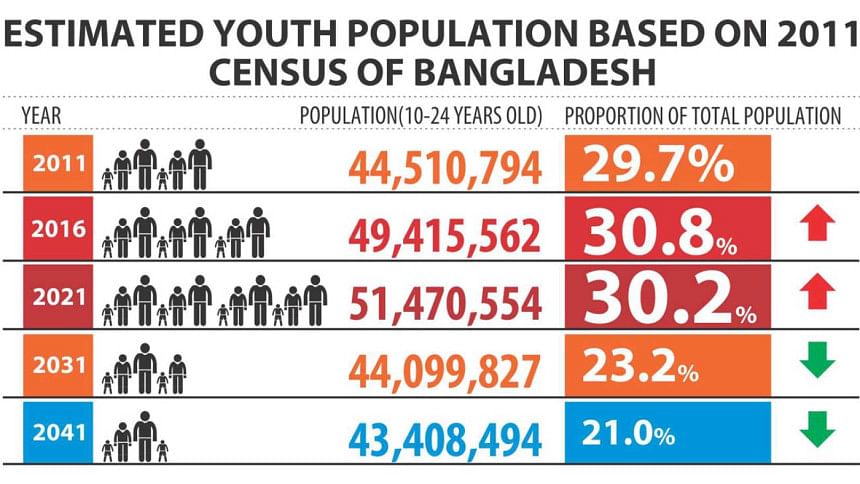Harnessing the strength of the young

In 2015 the Millennium Development Goals (MDGs) draw to a close and the UN Member States decide on the Sustainable Development Goals (SDGs) to guide global development until 2030. The implementation of this new development agenda will depend largely on the demographic changes taking place over the next 15 years and beyond. These changes will create both opportunities and challenges. One of the biggest challenges will be how to adjust to an unprecedented world population of 8.4 billion by 2030 while also ensuring a more equitable and inclusive pattern of economic growth and sustainable development for all.
Globally, the number of young people is at an all-time high.The estimated number of 15 to 24 year-olds is 1.2 billion in 2015 and this is projected to increase to nearly 1.3 billion by 2030.As mortality and fertility decline, countries typically enjoy a period when the ratio of working-age population to both young and old dependents, rises.This provides a one-time “demographic window of opportunity” before the dependency ratio rises again with the growth of the elderly population; however, it is not automatic or guaranteed that this one-time demographic window of opportunity will actually lead to a “demographic dividend”.It will turn into a demographic dividend only if the country invests heavily now in health, education, skills development, and employment generation, especially for the adolescents and youth. Advancing gender equality and women's empowerment is another key component that requires special attention in Bangladesh.
More specifically, the demographic “dividend” will be harnessed if three conditions are met. First, improvements in health status, especially children's and women's health, will contribute both to improved child survival and a decrease in the number of children born to each family in successive cohorts, thus accentuating the population bulge in the cohorts now entering or about to enter the working ages.Second, those in these large cohorts and the smaller cohorts that follow them will benefit from investment in education and health. As families have fewer children, they and the government have more resources to invest in the education of the surviving children, and women can increasingly enter the labor force. The third and final condition is having an economically enabling environment where those in the educated cohort/bulge can find well-paying jobs.
In the past four decades a breath-taking demographic transition has taken place in Bangladesh, triggered by a significant fall in both fertility and mortality rates. In 1974 a Bangladeshi woman on average gave birth to 6.3 children, compared to 2.3 nowadays. Other indicators such as the infant and under-five mortality rates have also decreased from74to 38 and 78.7 to 47, per 1000 live births, respectively and average life expectancy at birth has increased from 45 years to 70 years. These dramatic improvements in fertility and mortality have led to a significant shift in the age structure of the country's population. The share of the 0-14 age group has declined quite considerably from 48% to 35% while there has been steady and significant increase in the share of the15-64 age groupin the populationwith an especially high increase from 1991-2011.Currently approximately 31% of the entire population are young people (10-24) making up an impressive potential labour force for the next forty to fifty decades. It is also important to note that even though 31% of the current population consist of young people, it is projected that only 10-19% of its population will consist of young people by 2050 (UNFPA SWOP 2014). This means that Bangladesh needs to invest right now in the human capital of its young people, if the country is to benefit from this large cohort of the population and ensure they are able to meet the development needs of the country.
The proportion of working age population (15-59 years) to the total population reached its peak (59% of its current total 158million population) and will continue to grow for at least another two decades before it falls again.
The recent Demographic Impact Study conducted by UNFPA with financial support from the European Union, reveals that during the period 2000-2010 around 21.4 million peoplewere added to the country's total working age population due to population growth; of these, 16 million became economically active. Bangladesh's economy has however only absorbed just under 50 percent of the increase in the working age population in a satisfactory way. The other half is either unemployed, underemployed or not in the labour force at all. Although the number of women in paid jobs has increased it is still very low and female unemployment rates are exceptionally high. Considering the fact that by 2041 there could be 100 million women living in Bangladesh their potential for contributing to socio-economic development of the country is enormous and largely untapped. A critical factor influencing girls' education lies in the practice of Child Marriage. It leads to a high teenage fertility rate, which currently still stands at 113/1000. Only by ending Child Marriage, ensuring women's empowerment, education and labour force participation the demographic dividend can be realized.
Another critical issue to be addressed relates to the further development of the industrial and services sectors. Bangladesh needs to expand its industrial sector beyond the ready-made garments (RMG) industry, on which it is currently heavily reliant. Besidesmeasures to build the capacities of the workforce, this will require the identification of productive niches in which Bangladesh has or can develop a comparative advantage. Given the workforce's relatively low levels of education, the emphasis will need to be on industrial activities which, like the successful RMG and construction industries, can provide employment to those with only limited education.
The demographic dividend provides an opportunity for this maturing and transition of Bangladesh's industrial sector, if addressed appropriately. The government needs to focus on job creation in both the short and long-term, by promoting SMEs and self-employment in the industrial and service sectors, and by diversifying agricultural production to emphasize higher-yielding crops in the near future and through a strategy which gradually shifts the economy towards a more skilled and knowledge-based employment structure, consistent with the growing educational levels of the workforce.

 For all latest news, follow The Daily Star's Google News channel.
For all latest news, follow The Daily Star's Google News channel. 



Comments